And 6 more tips for writing during the pandemic
Greetings from my kitchen counter, where I have sat for infinity days, wearing the same grey loungewear, eating my weight in comfort food, thinking about writing.
Here are 7 more tips on writing during the Covid-19 pandemic — or any crisis.
1. Best Covid-19 executive messages — hands down.
The most powerful writer of the pandemic is a surgeon.

Dr. Craig Smith, chair of the Columbia University Department of Surgery, has been cranking out daily Covid-19 messages to faculty and staff that are so beautiful, they’ve been bringing me to tears.
They’re filled with great analogies, anecdotes and rousing lines, history lessons, insightful quotes and other rhetorical flourishes. They’re like sitting down to dinner with your most brilliant friend. They’re devastating reality checks that somehow also provide hope.
Here’s Smith’s — SNIFF! — final message. You’ll find my notes in red throughout.
Dear Colleagues,
In 1977 Peter Medawar, a 1960 Nobel Prize winner, defined a virus as “simply a piece of bad news wrapped up in protein.” I usually counsel against using a quote lead. Not this time. Perfect way to start up.
42 years later the bad news was the novel Coronavirus SARS-CoV-2. It was having its way with us 59 days ago, when I wrote my first Update to the Department of Surgery. We were shutting down ORs and research labs. The scarcity of PPE was frightening. Information was a salad nice analogy of confusing rumors, rambling emails, and pronouncements from multiple sources.
I attempted to write a simplifying summary. I wrote another, then another. I sensed that people sharing such universal dislocation great insight for your pandemic messages: needed morale as much as information. I grew tired of using the phrases “fingers crossed” and “when the dust settles.”
Near the beginning of Groundhog Day, the Bill Murray character says “Well, what if there is no tomorrow? There wasn’t one today.” Perfect pop culture anecdote/analogy for these times. March was tomorrow-less. Beautiful line. New cases were doubling fast, and we could only guess when we would bend the curve. Extraordinary individual effort and motivation carried us. April was equally exhausting but less terrifying as the curve bent and plateaued. Past-peak feels more like navigating home to harbor down the backside of the hurricane. Spectacular analogy.
As we’re constantly reminded, our home harbor will have changed, in the new-normal. Did you know that the magnetic North Pole has emigrated from Canada to Siberia? No, I didn’t, and what a perfect image for our “new normal.” The position of the magnetic North Pole is determined by iron and nickel flux in earth’s molten core, and is subject to a tug-of-war between two strong foci, one in Siberia and one in Canada. It has been moving steadily towards the Siberian focus for years. The pace accelerated in the 1990s. Like any other tourist, it crossed the international date line in 2017. To keep systems like GPS aligned a major update was required in 2019, just in time for SARS-CoV-2 to navigate around the world. Great details to point out our new North.
Powerful verb, image: Drive an arrow through the center of rotation of the earth from south to north, and it will emerge in the Arctic Ocean, about 300 miles from the vagrant magnetic North Pole. I love the details in this extended analogy: The arrow will point at the North Star (Polaris, formerly a-Ursae Minoris) at the end of the handle of the Little Dipper, 133 parsecs away. The earth wobbles on its axis, like a spinning top, a movement called “precession.” That causes the arrow to inscribe a circle through the universe over time, pointing at different stars. At the time of the Pyramids, Polaris was Thuban, in the constellation Draco (the Dragon). About 14,000 years from now Polaris will be Vega, the fifth-brightest star visible from earth. In 26,000 years a-Ursae Minoris will wear the Polaris crown again. Great way to pull it all together with a powerful, short, summary line: True north becomes new north.
At Bill Murray’s epiphany in Groundhog Day, he says “Do you know what today is? Today is tomorrow. It happened!” Nice way to extend this metaphor/story.
We have made the turn to the execution phase, on the return path to new-normal. It carries a different kind of excitement. Another pivot point sentence: short, and the whole thing is an analogy: Our Marshall Plan.
With the terror diluted, people seem happier and the crisis feels less compelling, but fear is still there. Fear of future surges, fear of economic struggle, and fear of the unknown, because “normal” is gone. In the execution phase people like me begin returning to their accustomed roles as elements of production, treating diseases pushed aside by Covid-19. It’s uplifting to be back in the OR today doing heart surgery again. I like how he drops himself in here, without making the whole piece about him.
The pole star I’ve followed through 59 Updates is moving. I feel my motivation leaning away from filling a void toward meeting an expectation. Perhaps that’s my void, that provokes a performance that’s a tiny bit too self-conscious, and takes me closer to Great example of balance: the fine line between full of knowledge and full of myself. This should be tattooed on every executive’s wrist.
Whatever, it’s time for a pause. The new-normal will not include Updates every day. “No man ever steps in the same river twice, for it is not the same river, and he is not the same man.” Mush on, Heraclitus!
Below this message, you’ll find links to Smith’s previous messages. Study them. Then model your own executive messages after them. Now, during the pandemic, and after, when tomorrow finally becomes today.
Want to write messages that move readers to tears? Learn how at our Master the Art of the Storyteller Master Class.
2. Develop creative story packages.
Creativity hasn’t gone into lockdown during the pandemic. Check out these brilliant story packages, all from The New York Times:
“‘I’m Teaching Into a Vacuum’: 14 Educators on Quarantine Learning” is a package of portraits of and quotes from teachers trying to instruct schoolchildren via Zoom:

How can you illustrate provocative sound bites for your next person-on-the-street roundup?
“The Pandemic Has Turned Los Angeles Into a Walking City” is George McFetridge’s graphic story of his own family’s life in lockdown.
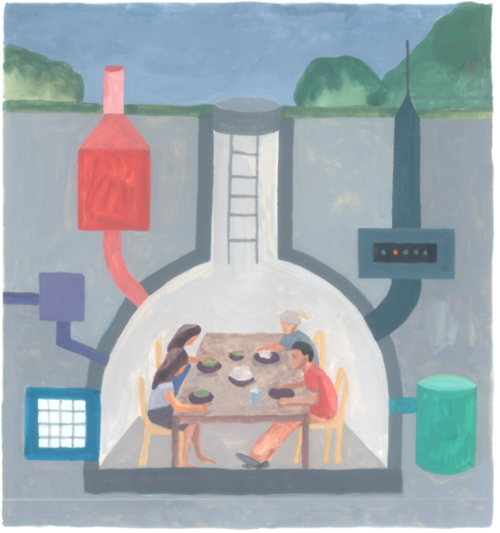

How can you tell your employees’ or clients’ stories through illustrations and short snippets?
“An Incalculable Loss” is a data visualization of 100,000 people, punctuated with one-sentence profiles to humanize the numbers. What does 100,000 look like? This …
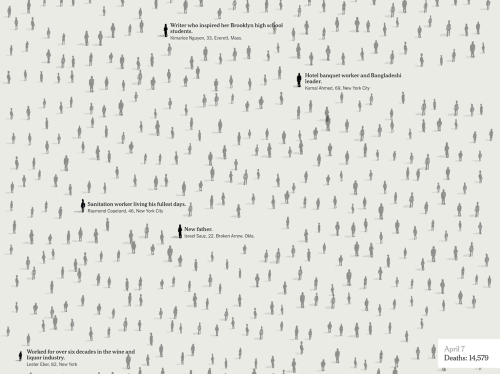
“Remembering the Nearly 100,000 Lives Lost to Coronavirus in America” filled the front page with of names of the dead — and nanoprofiles like “Put himself through college.”
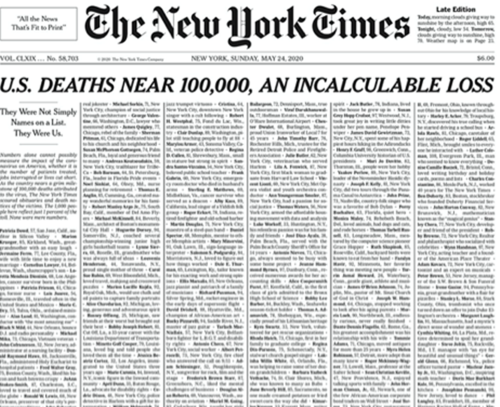
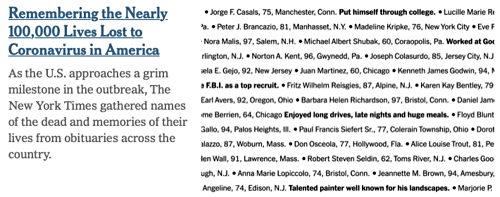
Read the story behind this story.
“260,000 Words, Full of Self-Praise, From Trump on the Virus” is an interactive infographic and in-depth piece of enterprise reporting.

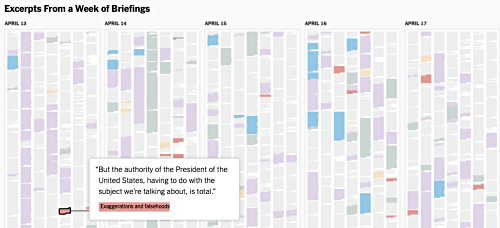
How can you come up with more compelling story ideas? Learn to master the creative process at our How to Write Better, Easier & Faster Master Class.
3. Avoid Institutional Narcissism.
Here’s the lead from a Covid-19 message from the United Airlines CEO:
 “When it was announced in 2019 that I’d be taking on the role of CEO at United, no one knew that our world was going to change so considerably. But my vision for our airline remains the same: that we’ll be able to offer the best customer experience, the most innovative technology and the most exciting destinations of any airline in the world. After watching our United family take on the challenges of the last few months, I know that together we can achieve that vision.”
“When it was announced in 2019 that I’d be taking on the role of CEO at United, no one knew that our world was going to change so considerably. But my vision for our airline remains the same: that we’ll be able to offer the best customer experience, the most innovative technology and the most exciting destinations of any airline in the world. After watching our United family take on the challenges of the last few months, I know that together we can achieve that vision.”
Dude! On the long list of things that I’m not interested in thinking about at all right now are: your job, your career, any 2019 announcements about your job and your career, your vision, your customer service, your innovative technology, the United family, your challenges and, again, your vision.
Apparently, talking about yourself activates the same pleasure centers in the brain as food, money or sex, according to Harvard neuroscientist Diana Tamir and her colleague Jason Mitchell, whose research on the topic was published in the Proceedings of the National Academy of Sciences.
Please remember that reading about you, though, activates no pleasure centers in your readers.
The reader wants to read about the reader. So tell me how you’re going to help me achieve my vision, don’t prattle on about yours. Make sure nobody ever says of your pandemic communications, “You’re so vain, you obviously think this Covid-19 message is about you.”
Read more about Institutional Narcissism:
Want to avoid Institutional Narcissism and write messages that appeal to readers’ own interests, not just the CEO’s? Find out how at our Catch Your Readers Master Class.
4. Lift Ideas Off the Screen.
The writers of this message from Iberia had the right idea. Someone in the airline’s communications office knew that people don’t read, they scan, especially on screen.
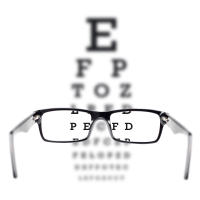 So the comunicator lifted some words off the screen with boldface type to help “readers” scan.
So the comunicator lifted some words off the screen with boldface type to help “readers” scan.
But which words? And what message do scanners get when they skim them?
In this case:
They have been some of the strangest and most distressing … pain, loss, stress … my first words … comfort and support … a light at the end of the tunnel … meeting up again … of course, traveling … living again … at Iberia … be there for you … flying … return to flying … many things are going to change … Now is that time … your safety and security …
Not exactly a coherent message!
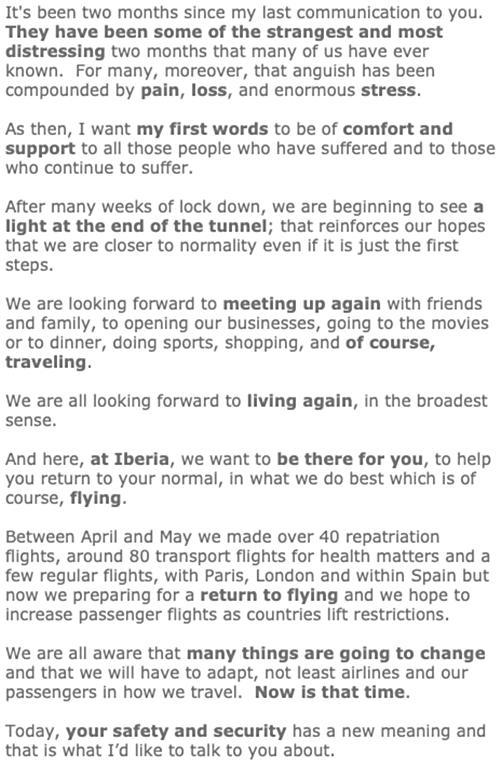
Instead of just highlighting random words into sort of a hallucinatory haiku, pass The Skim Test:
- List the key points you want readers to take away from this message.
- Assign each point to a piece of display copy — boldfaced text, sure, but also headlines, decks, subheads, bullets, links and boldfaced lead-ins.
- Test it by handing off the display copy only to someone who’s not familiar with this assignment. If they can read back to you your key points, you pass The Skim Test. If not, you need to keep working.
Finally, remember: If you highlight everything, you highlight nothing. If you highlight a phrase or two in every short paragraph, you’re probably overdoing it.
Learn more techniques for reaching readers where their eyes are at our Reach Readers Online Master Class.
5. Check out our favorite PR-writing quotes …
Here are a few of my favorite quotes about PR writing:

“Organizations write press releases for themselves, not for readers.”
— A frustrated PR pro
“What I really like about a [press release] is when it scratches my reader’s itch and not your client’s itch.”
— A trade journal editor quoted in Public Relations Tactics
“One of the top two abilities lacking in entry-level PR pros: strong writing skills.”
— WorkInPR survey
Are you scratching your readers’ itch? Learn how to write reader-focused media relations pieces at our PR-writing workshop.
What are your favorite PR-writing quotes? Please hit reply and let me know.
6. Check out these Covid-19 communication tools.
Here are more places to score Covid-19 communications resources:
- NEW! “How to Write During the Pandemic: Make Messages Compassionate, Confident and Clear,” a webinar by me, with IABC. This will be substantially revised from my previous C-19 webinar.
- NEW! Dr. Craig Smith’s Covid-19 messages to colleagues at the Columbia University Department of Surgery
- NEW! Siddhartha Mukherjee’s “How Does the Coronavirus Behave Inside a Patient?” essay for The New Yorker — speaking of brilliant doctors who are also brilliant writers
- Covid-19 resources from IABC
- Crisis communications resources from PRSA
- Daily coronavirus updates from PR News
- How to Write During Covid-19. Watch this webinar from PRSA and me free with coupon code WYLIE420.
- How to write during Covid-19. Crisis communication guru Molly McPherson interviews me for her podcast.
- Upskill during your downtime with our online Master Classes.
Please hit reply and let me know your favorite Covid-19 resources.
7. Need a break?
I’ll be honest. I was hoping that by the end of lockdown, I would have mastered salsa dancing and the Spanish language. Instead, I have mastered feeding myself without hotel bars and Hulu.
Here are some of the ways I’ve been enjoying frittering my quarantine away:

- Ogling The Alvin Ailey All Access website and the Alvin Ailey YouTube channel. To clarify: I am watching, not dancing.
- Listening to Patrick Stewart read Shakespeare’s sonnets, every day
- Reading Tolstoy Together in a reading club with Yiyun Li
- Going on virtual walking tours with The New York Times’ architecture critic
- Taking virtual museum tours. Note: The Oslo Picasso show is out of this world.
- Working on my Motown moves with the Ain’t Too Proud. To clarify, I am not watching, but dancing in my PJs with my cats.
***
What do you need from me during the pandemic? Please hit reply to email me your questions, examples and ideas, I’ll try to address them in the next issue.
See you next week!
